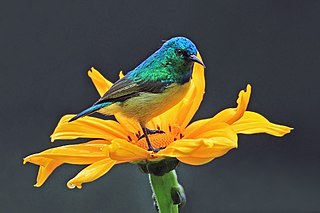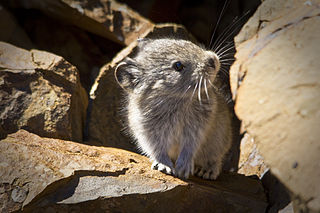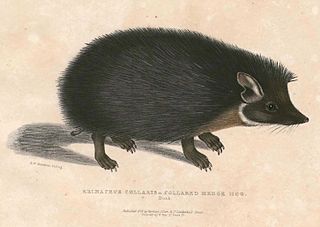
The ring-necked duck is a diving duck from North America commonly found in freshwater ponds and lakes. The scientific name is derived from Greek aithuia an unidentified seabird mentioned by authors including Hesychius and Aristotle, and Latin collaris, "of the neck" from collum, "neck".

Crotaphytus is a genus of lizards commonly known as collared lizards. They are a genus of small to medium-sized predators indigenous to arid environments of the southwestern regions of North America.

The alpine accentor is a small passerine bird in the family Prunellidae.

The collared sunbird,, is a sunbird. The sunbirds are a group of very small Old World passerine birds which feed largely on nectar, although they will also take insects, especially when feeding young. Collared sunbird is in fact mainly insectivorous.

The collared trogon is a near passerine bird in the trogon family, Trogonidae. It is found in the warmer parts of the Neotropics and includes numerous subspecies, including T. c. exoptatus from northern Colombia, northern Venezuela and Trinidad and Tobago. The subspecies T. c. aurantiiventris is recognized by many authorities as a separate species: the orange-bellied trogon.

The common collared lizard, also called eastern collared lizard, Oklahoma collared lizard, yellow-headed collared lizard or collared lizard, is a North American lizard that can reach 8–15 in (20–38 cm) in length, with a large head and powerful jaws. They are well known for the ability to run on their hind legs, looking like small versions of the popular images of theropod dinosaurs. Chiefly found in dry, open regions of Mexico and the south-central United States including Missouri, Texas, Arizona, and Kansas, the full extent of its habitat in the United States ranges from the Ozark Mountains to southern California. The collared lizard is the state reptile of Oklahoma, where it is known as the mountain boomer.

The collared pika is a species of mammal in the pika family, Ochotonidae, and part of the order Lagomorpha which comprises rabbits, hares, and pikas. It is a small (~160 gram) alpine lagomorph that lives in boulder fields of central and southern Alaska (U.S.), and in parts of Canada, including northern British Columbia, Yukon, and western parts of the Northwest Territories. It is closely related to the American pika, but it is a monotypic form containing no other recognized subspecies. It is asocial, does not hibernate, and spends a large part of its time in the summer collecting vegetation that is stored under rocks ("haypiles") as a supply of food for the winter. Some individuals have been observed collecting and consuming dead birds as sources of fat and protein. Thousands of trips are made during July and August to collect vegetation for winter.

The Indian long-eared hedgehog is a relatively small hedgehog native to India. It is insectivorous and nocturnal.

The hog badger, also known as the greater hog badger, is a terrestrial mustelid native to Central and Southeast Asia. It is listed as Vulnerable in the IUCN Red List of Threatened Species because the global population is thought to be declining due to high levels of poaching.

The Sangihe scops owl is an owl endemic to the island of Sangihe.

The semicollared hawk is a bird of prey species of in the family Accipitridae. It is found in Colombia, Ecuador, Peru, and Venezuela. Its natural habitat is subtropical or tropical moist montane forests. It is becoming rare due to habitat loss.

The collared lark or collared bushlark is a species of lark in the family Alaudidae found in East Africa.

The collared gnatwren is a species of bird in the family Polioptilidae. It is found in Brazil, Colombia, Ecuador, French Guiana, Guyana, Peru, Suriname, and Venezuela. Its natural habitat is subtropical or tropical moist lowland forests.

The collared brown lemur, also known as the red-collared brown lemur or red-collared lemur, is a medium-sized strepsirrhine primate and one of twelve species of brown lemur in the family Lemuridae. It is only found in south-eastern Madagascar. Like most species of lemur, it is arboreal, moving quadrupedally and occasionally leaping from tree to tree. Like other brown lemurs, this species is cathemeral, lives in social groups, primarily eats fruit, exhibits sexual dichromatism, and does not demonstrate female dominance. The species is listed as Endangered by the International Union for Conservation of Nature (IUCN) and is threatened primarily by habitat loss.
Cneoglossidae is a family of beetles, in the large suborder Polyphaga.

Sybra is a genus of beetles in the family Cerambycidae, containing the following species:

Sybra umbratica is a species of beetle in the family Cerambycidae. It was described by Pascoe in 1865.

Sybra ordinata is a species of beetle in the family Cerambycidae. It was described by Bates in 1873.
Sybra pascoei is a species of beetle in the family Cerambycidae. It was described by Lameere in 1893.
Xenolea collaris is a species of beetle in the family Cerambycidae, and the type species of its genus. It was described by James Thomson in 1864. It is known from Indonesia, Taiwan and the Philippines.


















